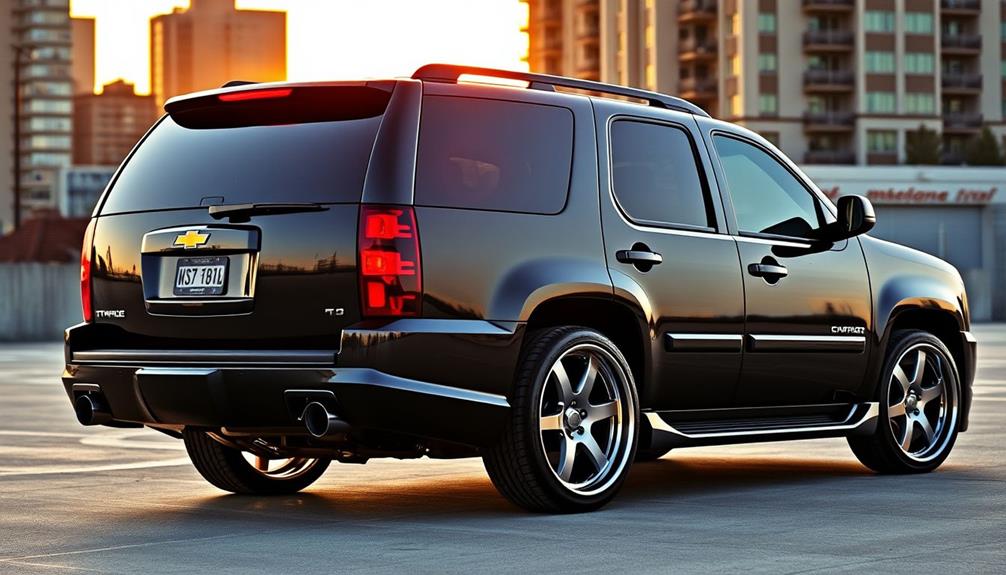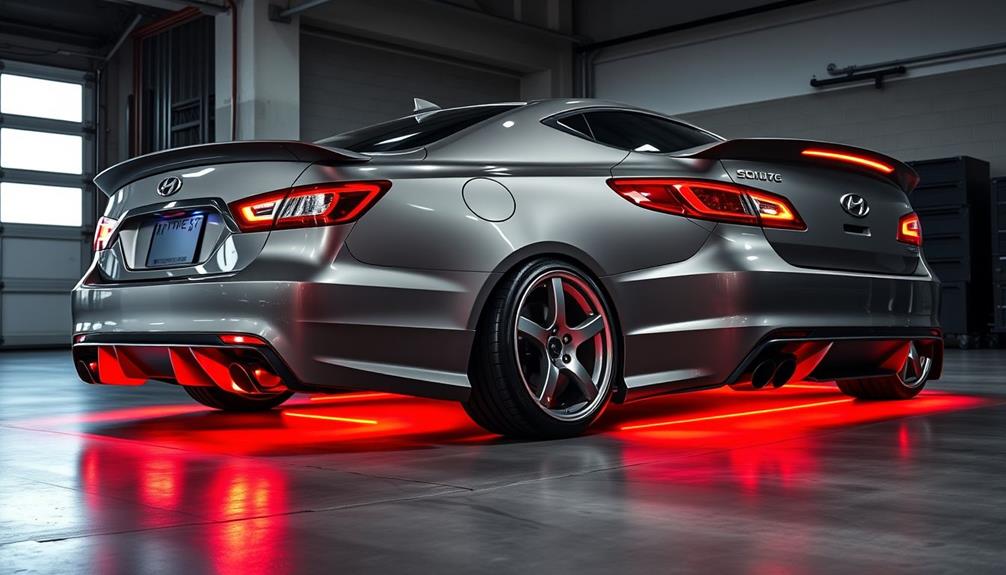To maximize your Hyundai's performance, you'll want to explore various tuning software options tailored to your needs. Tools like TOAD Pro offer a user-friendly experience for reading fault codes, while K-Tag Slave makes quick ECU adjustments simple. For more advanced users, the Elite Software Programmer provides enhanced mapping features. You'll experience impressive gains in horsepower and fuel efficiency, especially in models like the Kona and Elantra. Plus, with options like Pedal Commander, you can improve throttle response without extensive modifications. Stick around to uncover even more insights on achieving your car's peak performance.
Key Takeaways
- TOAD Pro offers a user-friendly interface for reading and erasing fault codes, making it ideal for beginners.
- Elite Software Programmer provides advanced 4D mapping for experienced users seeking maximum performance enhancements.
- K-Tag Slave enables quick ECU adjustments, cloning, and backup support for effective tuning.
- PrecisionCodeWorks allows easy remapping for novices, requiring credit purchases for modifications.
- Aftermarket solutions like Pedal Commander significantly improve throttle response without compromising engine integrity.
Overview of Hyundai Tuning Software
Hyundai tuning software offers a range of options tailored to different user needs and expertise levels. Whether you're a novice or a seasoned expert, there's a tool that fits your requirements for effective chip tuning.
For instance, TOAD Pro stands out with its user-friendly interface, allowing you to read and erase fault codes while optimizing engine efficiency across OBD1 and OBD2 vehicles. If you're looking for advanced features, the Elite Software Programmer provides 4D mapping for boost, ignition, and fuel tables, although it's on the pricier side with limited extras.
K-Tag Slave is another solid choice, enabling quick ECU adjustments and supporting cloning and backup for any make or model. However, keep in mind that some modifications may incur additional fees.
For beginners, PrecisionCodeWorks is an excellent option, allowing you to easily remap by uploading original ECU files. It services over 3,000 customers monthly but requires purchasing credits for new calibrations.
With these diverse Hyundai tuning software options, you can find the perfect solution to enhance your vehicle's performance effectively.
Benefits of Vehicle Remapping
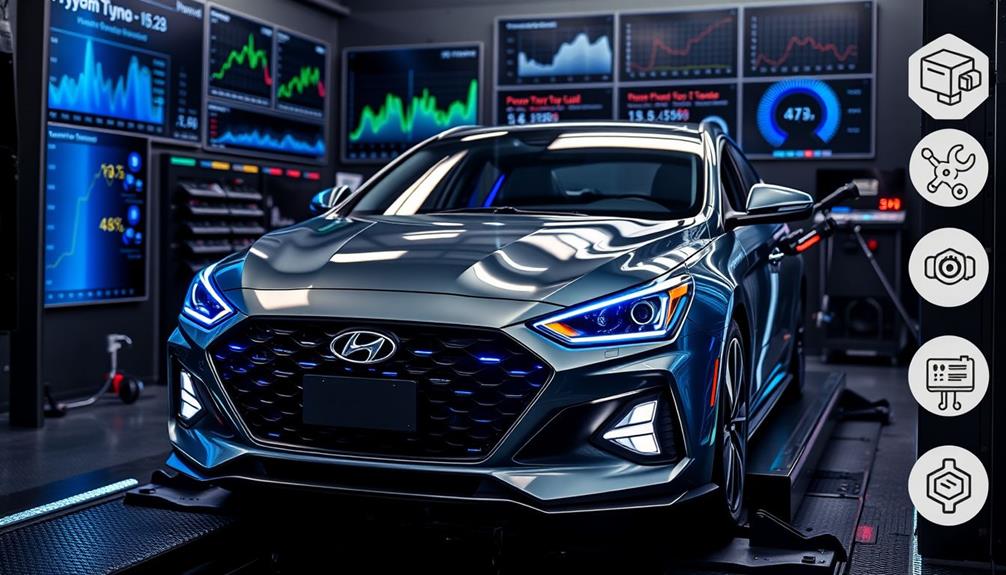
Tuning your vehicle through remapping can deliver impressive performance enhancements that many drivers crave. By optimizing engine parameters like boost, ignition timing, and fuel delivery, vehicle remapping allows you to access significant gains—potentially adding 40-60 horsepower while boosting fuel economy by up to 5 MPG. This means you can enjoy an exhilarating driving experience without sacrificing efficiency.
One of the standout benefits of remapping is improved throttle response. You'll notice reduced lag and quicker acceleration, especially in models like the Hyundai Kona 1.6 T-GDI. This enhancement not only makes your car more fun to drive but also contributes to better handling and overall dynamics.
Using reputable tuning software, such as the TOAD Pro OBD2 ECU tuning software, guarantees that your modifications are safe and maintain your engine's integrity.
You'll also have access to features that let you read and erase fault codes while generating detailed diagnostic reports, aiding in better vehicle maintenance.
Popular Hyundai Models for Tuning
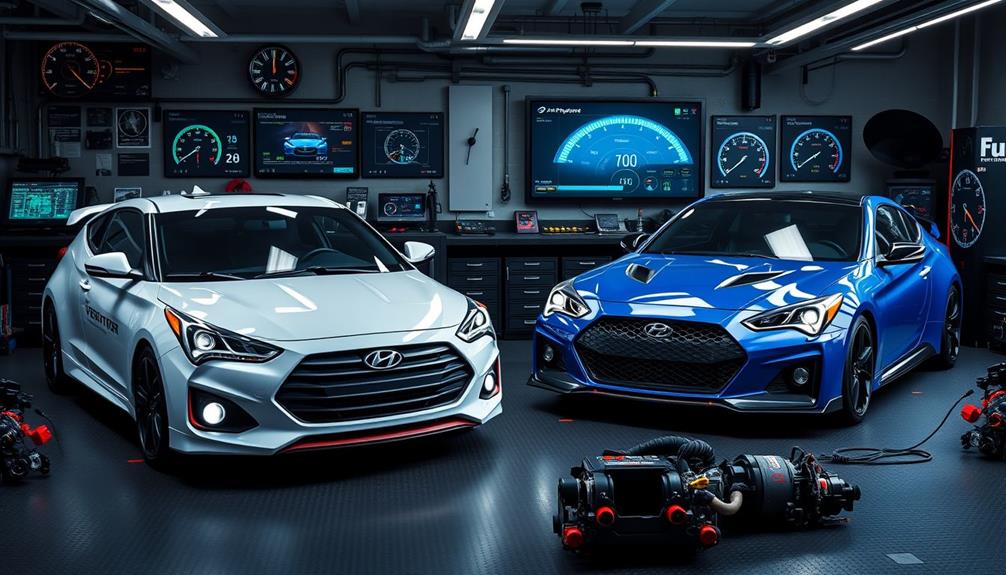
If you're considering tuning your Hyundai, there are several top models to explore.
The Hyundai Accent, Elantra, and Creta are all highly rated and offer great potential for performance enhancements.
Each model brings unique advantages, so it's worth looking into the specific tuning options available for your vehicle.
Top Tuning Options
For car enthusiasts looking to boost performance, several popular Hyundai models stand out as excellent candidates for tuning. The Hyundai Accent and Aura (2020-Present) are top choices, offering performance chips that can enhance horsepower by an impressive 40-60 HP while improving fuel efficiency by up to 5 MPG.
If you own a Hyundai Elantra (2000-2016), you'll appreciate its strong 4.50/5 customer rating, making it a reliable option for aftermarket tuning solutions like the VIEZU V-Box for diesel tuning.
The Hyundai Creta / ix25 (2015-2019) is another model worth considering, with tuners reporting significant improvements in throttle response and overall performance through easy plug-and-play solutions.
The Hyundai H-1 and Alcazar are also popular tuning options, priced at £249.00, offering various remapping choices to maximize engine efficiency and power output.
Lastly, if you drive a Hyundai Kona 1.6 T-GDI, you can gain up to 40 extra horsepower with the right tuning approach, such as ECU flash tunes or piggy-back tuners.
These models provide excellent avenues for enhancing your vehicle's performance through effective tuning strategies.
Performance Enhancement Benefits
When it comes to enhancing your Hyundai's performance, the benefits of tuning are hard to ignore. Popular models like the Elantra, Accent, and Creta have earned impressive ratings of 4.50 out of 5, making them prime candidates for tuning upgrades that can greatly boost performance.
For instance, tuning options for the Hyundai Kona 1.6 T-GDI can yield up to 40 additional horsepower and improved gas mileage, showcasing the remarkable performance enhancement benefits you can achieve.
One of the safest and most effective methods for tuning is through ECU flash techniques, like OBD2 flash tunes and ECU remapping. These options allow you to maximize your vehicle's capabilities without risking engine integrity or voiding your warranty.
Additionally, upgrades like the Pedal Commander can enhance throttle response and acceleration, further improving your driving experience.
For those seeking cost-effective enhancements, aftermarket solutions such as the VIEZU V-Box provide reliable performance gains for models like the Hyundai Accent and Elantra, offering solid alternatives to pricier OEM upgrades.
With these tuning options, you'll not only enjoy a more responsive vehicle but also better overall efficiency.
Model-Specific Considerations
Tuning your Hyundai is not a one-size-fits-all process; specific models come with their own unique considerations that can greatly impact performance outcomes. For Hyundai owners looking to improve your vehicle's performance, understanding the strengths of each model is key.
Here's a quick overview of popular Hyundai models for tuning:
| Model | Additional Horsepower | Customer Rating |
|---|---|---|
| Hyundai Kona 1.6 T-GDI | Up to 40 HP | N/A |
| Hyundai Elantra (2000-2016) | N/A | 4.50/5 |
| Hyundai Creta/ix25 (2015-2019) | N/A | 4.50/5 |
Models like the Hyundai Accent and Creta are also remarkable, as they consistently receive high ratings when tuned correctly. For a cost-effective investment, consider tuning the Hyundai Coupe or Alcazar, both priced around £249.
With user-friendly software like TOAD Pro and K-Tag Slave, you can easily navigate the tuning process, allowing both professionals and amateurs to optimize performance across these popular Hyundai models. Always keep in mind that the right tuning strategy can elevate your driving experience drastically.
Performance Upgrades and Enhancements
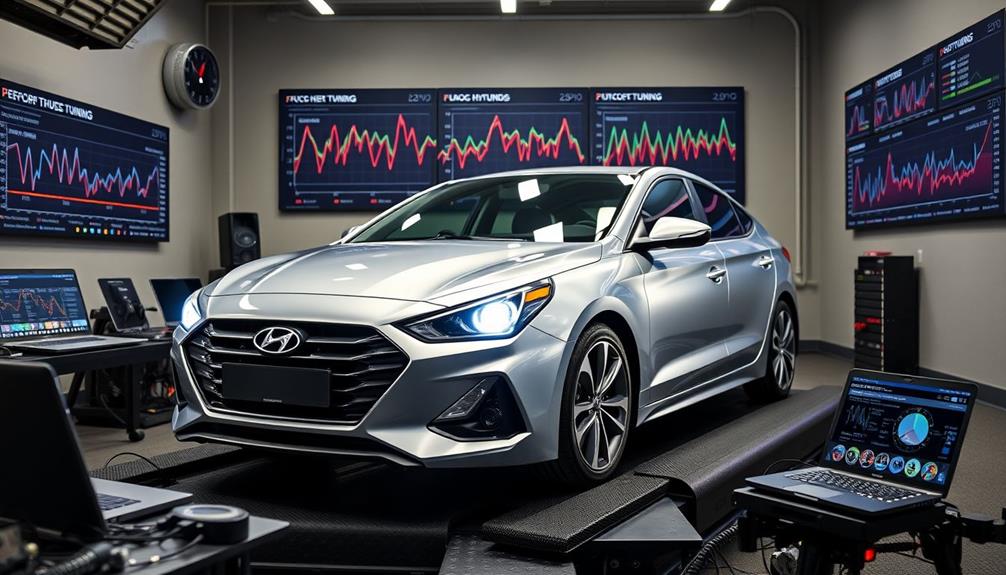
When you're looking to enhance your Hyundai's performance, improving throttle response is a key factor.
Upgrades like the Pedal Commander offer cost-effective modifications that boost your driving experience without risking engine safety.
These reliable options let you enjoy a more responsive ride while keeping your vehicle in top shape.
Throttle Response Improvement
Improving throttle response can greatly enhance your driving experience, and one of the most effective solutions for Hyundai owners is the Pedal Commander. This popular performance upgrade effectively removes throttle lag and markedly boosts throttle response in Hyundai cars, leading to improved acceleration that you'll feel immediately.
The Pedal Commander offers four distinct modes, allowing you to tailor your driving experience to various conditions. Whether you want to optimize fuel efficiency with its eco mode or release maximum power in sport mode, this tool has you covered.
Owners of models like the Elantra and Sonata have reported noticeable improvements in their overall vehicle performance and driving satisfaction after installation.
Installation is straightforward, ensuring compatibility across a wide range of Hyundai models without risking warranty voidance. By reducing gas pedal sensitivity, the Pedal Commander allows for a more responsive driving experience, making it a smart choice for anyone looking to enhance their vehicle's performance effectively.
With the Pedal Commander, you can enjoy a thrilling drive with improved throttle response, transforming your Hyundai into a more dynamic and engaging vehicle on the road.
Cost-Effective Modifications
Enhancing your Hyundai's performance doesn't have to break the bank. You can find plenty of cost-effective performance upgrades that improve throttle response and acceleration without risking engine damage or voiding warranties.
For instance, products like the Pedal Commander can deliver noticeable enhancements at a fraction of the cost of more complex modifications.
Consider the VIEZU V-Box Diesel Tuning Box, which retails for just £299.00. It provides reliable performance improvements that often outperform some OEM components, proving that you don't need to spend a fortune to see results.
With many Hyundai models, like the Accent and Elantra, boasting high customer satisfaction ratings, you can feel confident in your choices.
Additionally, utilizing ECU remapping tools can add up to 40 horsepower while also enhancing fuel mileage. This means you're not only boosting performance but also making a wise investment that benefits your wallet in the long run.
Community feedback shows that these tuning options lead to significant improvements in driving experience and overall fuel economy, often exceeding what larger engine vehicles deliver.
Safety and Reliability
Upgrading your Hyundai's performance shouldn't compromise safety or reliability. When you're considering performance enhancements, it's vital to choose options that prioritize both.
Products like the Pedal Commander enhance throttle response without requiring extensive modifications, ensuring your engine's integrity remains intact. This type of aftermarket option isn't only cost-effective but also reliable, often outperforming some OEM components while reducing the risk of engine damage.
Unlike traditional chip tuning, which can pose serious risks if not done correctly, safer alternatives improve acceleration without increasing engine power. This means you can enjoy a more responsive driving experience without compromising safety.
Proper research and selection of tuning options are important. Many aftermarket accessories can outperform OEM parts at lower costs while ensuring your vehicle's safety.
With the growing trend in DIY vehicle enhancements, you can achieve significant performance improvements while minimizing potential risks associated with traditional tuning methods.
Always remember that enhancing performance should never come at the expense of safety—by choosing the right upgrades, you can have the best of both worlds.
Aftermarket Vs. OEM Tuning Options
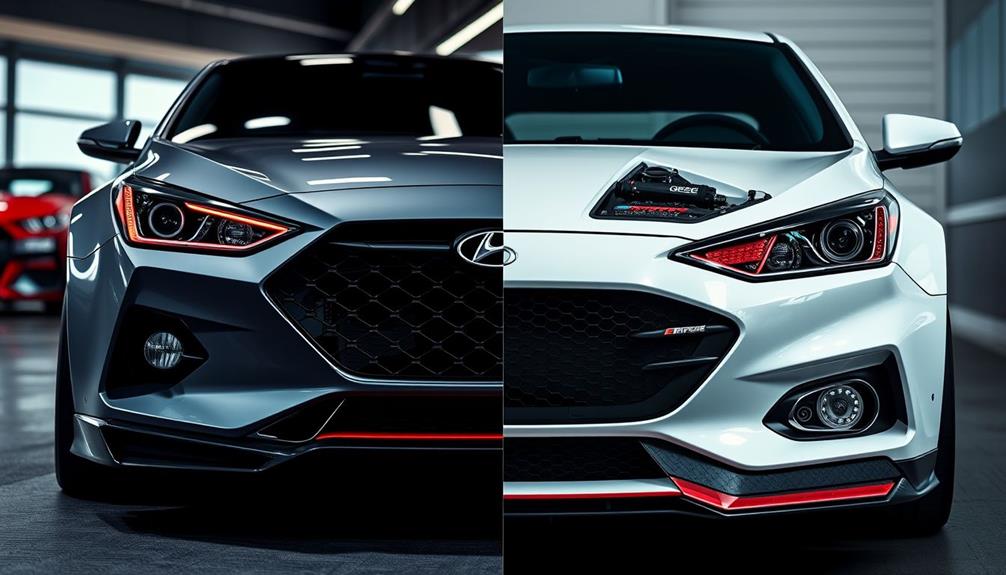
When it comes to tuning your Hyundai, you'll find two main options: aftermarket and OEM. Each has its own advantages, and understanding them can help you make the best choice for your car's performance.
- Cost-Effectiveness: Aftermarket tuning options, like the Pedal Commander, often provide performance enhancements at a fraction of the cost of OEM upgrades.
- Performance: While OEM parts are reliable, many aftermarket options can outperform them, offering improved throttle response and noticeable horsepower gains.
- Customization: Aftermarket solutions allow for more flexibility, letting you tailor your Hyundai's performance and aesthetics to fit your personal style.
Many aftermarket tuning devices, such as piggy-back tuners, are designed for easy installation and removal, keeping your manufacturer's warranty intact.
By researching reputable aftermarket brands, you could see impressive performance improvements, including gains of 40-60 horsepower and better fuel economy.
Ultimately, the choice between aftermarket and OEM tuning options depends on your priorities—whether it's cost, performance, or customization.
Weighing these factors will help you maximize your Hyundai's potential effectively.
Risks and Considerations in Tuning

Tuning a Hyundai can release impressive performance, but it's important to recognize the risks and considerations involved. Traditional chip tuning may promise increased horsepower and torque, but if not done correctly, it can lead to engine damage. That's why it's vital to research your tuning options thoroughly and understand the limits of your vehicle.
While performance chips can enhance power, they might push your engine beyond its safe limits. To mitigate risks, consider reliable tuning methods that prioritize engine integrity. A safer alternative is the Pedal Commander, which improves throttle response without requiring extensive modifications or excessive power increases, thereby reducing the chances of engine harm.
Be cautious with generic OBDII chips and low-quality tuners, as these can be detrimental to your engine's health. Always select reputable products to guarantee you're making a sound investment in your car's performance.
Engaging with community feedback can also provide valuable insights into the risks associated with tuning, helping you make informed decisions for your performance upgrades. By staying informed and cautious, you can enjoy the benefits of tuning while minimizing potential risks.
Community Insights and Experiences
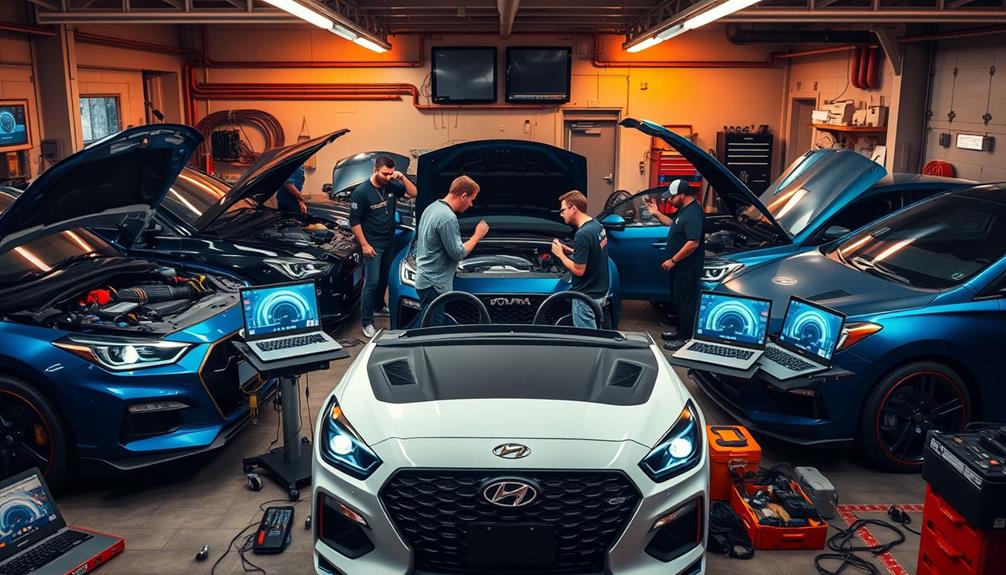
In the vibrant world of Hyundai tuning, community insights play an essential role in guiding your decisions. As you plunge into the domain of tuning products, you'll find that sharing experiences can notably impact your choices.
Here are three key takeaways from community discussions:
- Mixed Experiences: Users report varying satisfaction levels with different tuners, so it's imperative to do your research and explore firsthand accounts before committing to a product.
- Importance of Dyno Testing: Many enthusiasts stress the value of dyno testing for accurate performance metrics. Always question horsepower claims and seek out evidence to back them up.
- Recommendations on Reliability: Community members frequently recommend tuning brands that maintain engine integrity and warranty coverage, ensuring you enhance performance without compromising reliability.
Installation Considerations for Tuning
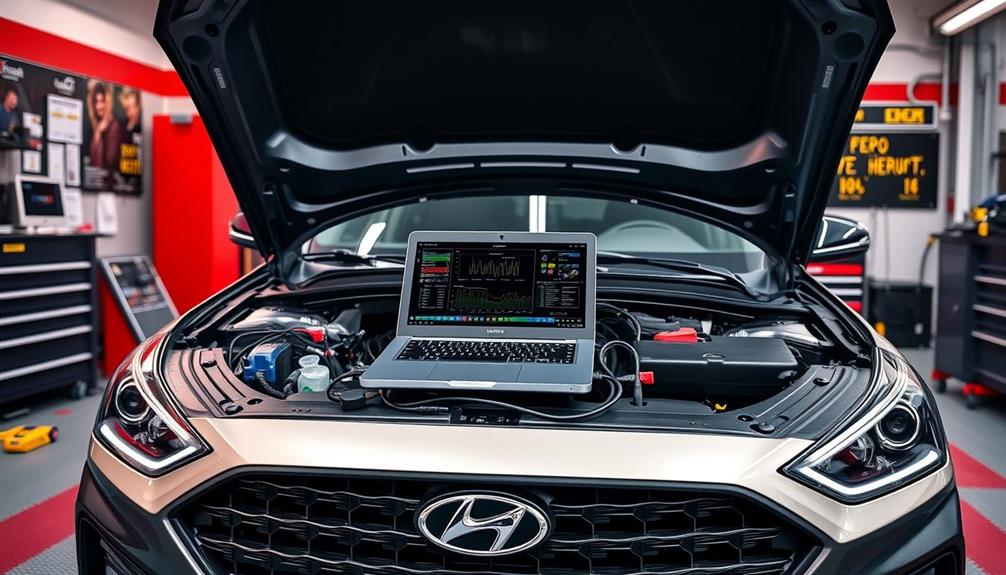
Selecting the right tuning software for your Hyundai involves careful consideration of installation factors to ascertain seamless integration with your vehicle. First, verify the software is compatible with your vehicle's OBD1 or OBD2 ports. This compatibility simplifies installation and guarantees the software functions correctly.
Consider opting for plug-and-play solutions like PTronic, which allow for straightforward installation and removal, minimizing downtime during service visits.
You'll want to research tuners that provide easy reinstallation processes, as they can save you from complications during routine maintenance.
Before diving into tuning, hold off until you have the proper setups and steer clear of generic OBDII chips, as they can compromise safety and performance integrity.
Additionally, if you're opting for piggy-back tuners, know that these can often be concealed, preserving your vehicle's appearance while enhancing performance without requiring extensive modifications.
Sourcing Quality Tuning Parts
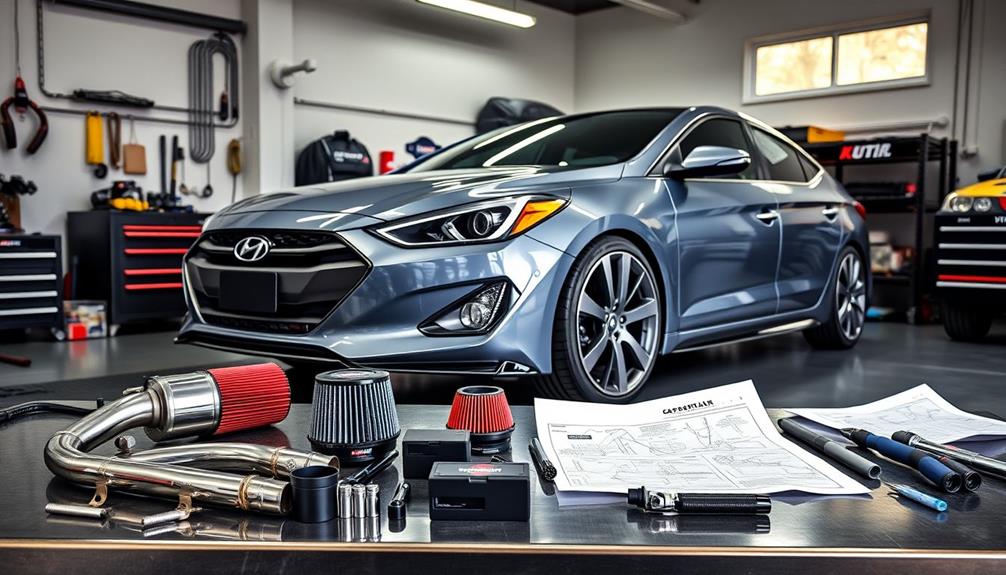
After confirming you've got the right tuning software in place, the next step involves sourcing quality tuning parts to enhance your Hyundai's performance.
Choosing the right components can make all the difference, so here are three key tips to get you started:
- Research Brands: Look into reputable brands like Pedal Commander, VIEZU V-Box, and PTronic. Their proven track records help guarantee you're investing in performance parts that deliver results.
- Engage with the Community: Join automotive forums and groups. They're goldmines for user experiences and recommendations on the best tuning parts for your Hyundai model.
- Explore Retail Options: Check both local and online retailers to widen your selection. This approach lets you compare prices and availability, assuring you find the best tuning accessories for your needs.
Quality control is paramount. Opt for established brands that offer warranties and customer support.
This way, you'll minimize risks associated with low-quality parts and enjoy a smoother installation process.
Frequently Asked Questions
What Is the Best Car Tuning Software?
When searching for the best car tuning software, consider your needs. Tools like TOAD Pro and PrecisionCodeWorks cater to various skill levels, while Elite Software Programmer offers advanced features for serious tuners. Find what suits you.
Can You Tune a Hyundai?
Yes, you can tune your Hyundai! With options like ECU remapping and OBD2 flash tunes, you'll likely boost horsepower and fuel efficiency. Just remember, improper tuning might lead to engine issues or void your warranty.
Does ECU Tuning Make Your Car Faster?
Yes, ECU tuning can make your car faster. Many users report gains of 40-60 horsepower, enhancing acceleration and responsiveness. Just guarantee you research thoroughly and consider dyno testing to prevent any potential engine damage.
What Does Tuning Software Do?
Tuning software lets you read and erase fault codes, adjust engine parameters like fuel and timing, and optimize performance. It also generates diagnostic reports, helping you track changes and maintain your engine's health effectively.
Conclusion
In the world of Hyundai tuning, you're not just tweaking numbers; you're releasing the full potential of your ride. Like a sculptor chiseling away at marble, each modification reveals the masterpiece within. With the right software and parts, your car can transform from ordinary to extraordinary, roaring down the road with newfound vigor. So embrace the journey, weigh the risks, and let your passion for performance guide you to the ultimate driving experience.

